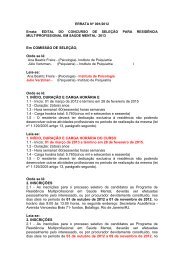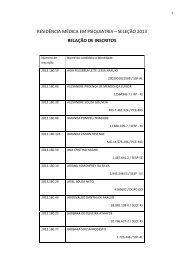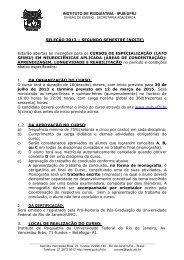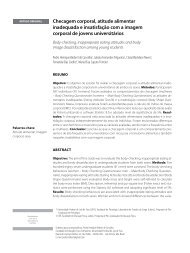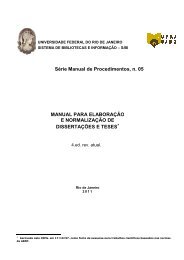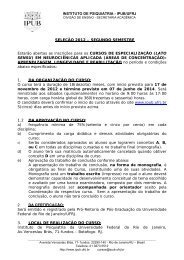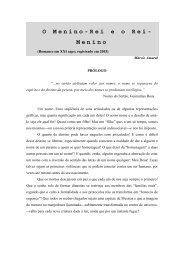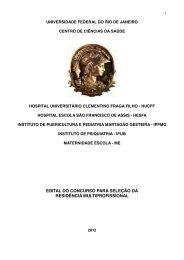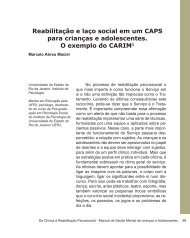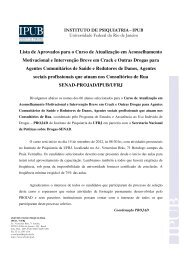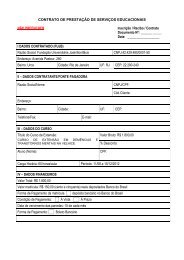Originais â Originals outubro | dezembro ⢠2011 - IPUB - UFRJ
Originais â Originals outubro | dezembro ⢠2011 - IPUB - UFRJ
Originais â Originals outubro | dezembro ⢠2011 - IPUB - UFRJ
Create successful ePaper yourself
Turn your PDF publications into a flip-book with our unique Google optimized e-Paper software.
ORIGINAL ARTICLE<br />
Eating habits and psychopathology in children and adolescents<br />
241<br />
Palavras-chave<br />
Hábitos alimentares,<br />
psicopatologia, crianças,<br />
saúde mental.<br />
objetivo foi verificar a sua sensibilidade para a identificação de fatores de risco em termos<br />
de comportamento/hábitos alimentares em crianças e adolescentes. Métodos: O NBI foi<br />
traduzido, adaptado e retrotraduzido. A versão em português do NBI foi então aplicada<br />
(N = 96; 9-12 anos). O instrumento foi analisado em relação à consistência interna por meio do<br />
índice alfa de Cronbach. Os indicadores psicopatológicos dos participantes foram acessados<br />
utilizando o Child Behavior Checklist (CBCL). Os escores médios do CBCL foram analisados em<br />
relação aos dados do NBI (ponto de corte: ≥ 30 com indicadores, e < 30 sem). Resultados:<br />
A consistência interna foi alta (alfa de Cronbach = 0,89) para o NBI. As pontuações do CBCL<br />
foram associadas significativamente com NBI (> 30) em relação aos indicadores: ansiedade<br />
e depressão (p = 0,041), dificuldades sociais (p = 0,028), problemas de atenção (p = 0,001),<br />
comportamento agressivo (p = 0,015), TDAH (p < 0,001) e problemas de conduta (p = 0,032).<br />
Conclusão: Os resultados indicam que o NBI é um instrumento confiável. O NBI pode<br />
ser útil para avaliar sintomas psicopatológicos relacionados com os hábitos alimentares e<br />
comportamentos de crianças e adolescentes.<br />
INTRODUCTION<br />
The etiology of mental disorders is complex and multifactorial,<br />
and more research is needed to decipher it. One of the most<br />
commonly accepted scientific hypotheses regarding the<br />
etiology of mental disorders is that there is a strong interaction<br />
between genetic predisposition and positive and/or negative<br />
environmental factors and that, therefore, interaction with<br />
the environment can affect the development of mental or<br />
physical health problems during a person’s lifespan 1 .<br />
The growing number of mental health problems has<br />
motivated scientists worldwide to study factors that provide<br />
protection from or increase vulnerability to the development<br />
of mental illness 2 . Furthermore, there is a need to find<br />
treatment approaches that are more effective than existing<br />
treatments, as well as to adopt a preventive posture.<br />
Nutrition and eating habits are environmental factors<br />
that can have a substantial positive or negative influence on<br />
mental health 3 . Nutrition and eating behavior merit particular<br />
during childhood and adolescence when maturation and<br />
brain development are accelerated. Appropriate attention<br />
to diet and adequate consumption of nutrients can be vital<br />
to the proper development of neurobiological processes<br />
during this period 4 . Moreover, a child’s dietary choices can<br />
have a strong impact on the way in which s/he learns, feels,<br />
and behaves 5 . The manifestation of early psychopathological<br />
symptoms of mental illness during adolescence, even<br />
when temporary, can be a harbinger of continued and<br />
even more serious mental health problems in adulthood 6 .<br />
Prevention measures should consider the timing of pediatric<br />
susceptibility and what environmental factors may “trigger”<br />
genetic predispositions to mental and behavioral disorders 6 .<br />
A number of studies have demonstrated a relationship<br />
between diet and mental health, but few clearly delineated<br />
scientific studies have addressed this question in subjects<br />
that are in important developmental phases, such as late<br />
childhood and the start of adolescence 7 . During this period,<br />
there are biological, psychological, and a social change that<br />
commonly gives rise to many behavioral changes.<br />
Although it is clear that there is a relationship between<br />
diet and mental disorders, there is not yet a consensus<br />
among scientists as to whether food preferences and choices<br />
are causative or consequential factors of mental disorders 8 .<br />
Early diagnosis can help to prevent problems of increasing<br />
prevalence in the West, especially if diagnosis is followed<br />
by appropriate preventative and therapeutic measures,<br />
including improvements in the quality of dietary practices<br />
in order to reduce the social and personal impact of mental<br />
disorders and behavioral problems in young people 9 .<br />
In 1980, Alexander Schauss developed the “Nutrition-<br />
Behavior Inventory” (NBI) for research examining the<br />
influence of diet on behavior. The NBI addresses behavioral,<br />
physical, and metabolic symptoms and their relationship<br />
to nutrition. It includes questions that enable evidence of<br />
habits involving high consumption of sugar, carbohydrates,<br />
and caffeine, as well as evidence of behaviors arising from<br />
metabolic and behavioral disorders, to be ascertained 10 . The<br />
NBI is an inventory with 52 questions, with each question<br />
addressing a particular symptom(s) of health, dietary habits,<br />
and behaviors. The form can be filled out with a pencil and<br />
takes 15~20 minutes. The higher the score (especially ≥ 30),<br />
the greater the probability that an individual has nutritional<br />
factors that affect their health and behavior 10 . The instrument<br />
can be applied in a self-reporting format with four answer<br />
choices, graded according to frequency as follows: “most<br />
of the time” (3 points); “often” (2 points); “rarely” (1 point);<br />
and “never” (0 points). Of the 52 questions on the NBI, 10<br />
probe for evidence that a person may have a blood sugar<br />
disorder; responses to these questions may also indicate a<br />
high consumption of refined carbohydrates and caffeine 10 .<br />
At the moment, the NBI is the only instrument that allows for<br />
this type of analysis, as most scales used in studies examining<br />
the relationship between dietary habits and behaviors<br />
are specifically directed at identifying eating disorders,<br />
J Bras Psiquiatr. <strong>2011</strong>;60(4):240-6.




